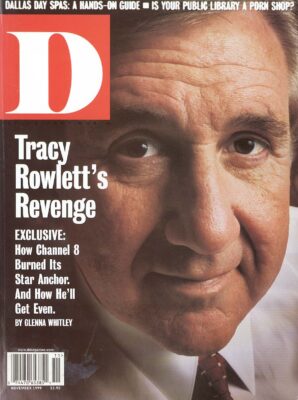Alarge white $60,000 customized GMC Starcraft van, loaded down with $250,000 of electronic gear, pulls out of Ericsson’s parking lot in Richardson.
Behind the driver a computer monitor suspended from the roof hooks Bryan Coley in a vidéoconférence with Keith Shank, who’s in a room tucked away in a corner of Ericsson’s first floor. Shank’s presence on the monitor is like watching a poorly dubbed movie: You hear his words, and then a few split seconds later you see his mouth form them. But, as the technology experts say, this is as bad as it’s ever going to be.
Coley’s laptop is connected to the Internet, down-loading e-mail and faxes, surfing web sites, and gathering slock quotes. He switches over to Yahoo Broadcast Services (formerly Broadcast.com) for a streaming video earnings call. Later, he uses Yahoo to latch on to a radio station in Chicago.
Then, using a hands-off phone, he carries on a conversation with such clarity thai it makes a normal cell phone call sound like a pre-Dolby 8-track tape as compared to a digitally recorded CD.
This is an expensive demonstration: All told, Ericsson has invested $1.2 million to show off its Bluetooth technology.
The whole idea is a departure for a telecom company that typically works behind locked doors, closely guarding its technology before announcing to the world that the latest gizmo or service is going to change the way we think, work. and play. But in a world working on compressed Internet time, the risk is that I the Next Big Thing will show up before the old lias caught on.
The company was losing market share in the $20 billion cell phone handset industry, down to 14 percent, while rival Nokia’s share was climbing to 27 percent. One way to sell more handsets and gain market share is to make them do more stuff. But rather than spend R&D funds on technologies Ericsson is not good at, the company decided to follow the model of software developers, who let others develop the new applications.
The van is the showpiece of Ericsson’s WAVElab (Wireless Applications Validation Environment Laboratory), which was set up to let outsiders test possible applications based on Bluetooth, a local wireless network that’s much faster than a standard computer modem. It uses cell phones to replace the cables that might normally connect all these devices.
So far, the technology looks promising for Ericsson. The company recently formed a partnership with a German group to develop information and entertainment applications for automobiles. A partnership with news agency Reuters will bring financial news and data to cell phones and other hand-held devices, such as Palm Pilots and laptops.
Coley, who heads up WAVElab, is absolutely giddy about the potential. He says he can’t begin to imagine all the possibilities. That’s why he’s confident that opening Ericsson’s previously locked doors will help the company realize its potential faster than it could on its own.
And sell more handsets.-Richard Urban
Get our weekly recap
Brings new meaning to the phrase Sunday Funday. No spam, ever.
Related Articles

Arts & Entertainment
DIFF Documentary City of Hate Reframes JFK’s Assassination Alongside Modern Dallas
Documentarian Quin Mathews revisited the topic in the wake of a number of tragedies that shared North Texas as their center.
By Austin Zook

Business
How Plug and Play in Frisco and McKinney Is Connecting DFW to a Global Innovation Circuit
The global innovation platform headquartered in Silicon Valley has launched accelerator programs in North Texas focused on sports tech, fintech and AI.

Arts & Entertainment
‘The Trouble is You Think You Have Time’: Paul Levatino on Bastards of Soul
A Q&A with the music-industry veteran and first-time feature director about his new documentary and the loss of a friend.
By Zac Crain


